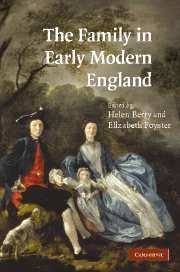Book contents
- Frontmatter
- Contents
- Preface
- Notes on contributors
- Anthony Fletcher
- 1 Introduction
- 2 Marriage, separation and the common law in England, 1540–1660
- 3 Republican reformation: Family, community and the state in Interregnum Middlesex, 1649–60
- 4 Keeping it in the family: Crime and the early modern household
- 5 Faces in the crowd: Gender and age in the early modern English crowd
- 6 ‘Without the cry of any neighbours’: A Cumbrian family and the poor law authorities, c.1690–1730
- 7 Childless men in early modern England
- 8 Aristocratic women and ideas of family in the early eighteenth century
- 9 Reassessing parenting in eighteenth-century England
- Select bibliography
- Index
4 - Keeping it in the family: Crime and the early modern household
Published online by Cambridge University Press: 31 July 2009
- Frontmatter
- Contents
- Preface
- Notes on contributors
- Anthony Fletcher
- 1 Introduction
- 2 Marriage, separation and the common law in England, 1540–1660
- 3 Republican reformation: Family, community and the state in Interregnum Middlesex, 1649–60
- 4 Keeping it in the family: Crime and the early modern household
- 5 Faces in the crowd: Gender and age in the early modern English crowd
- 6 ‘Without the cry of any neighbours’: A Cumbrian family and the poor law authorities, c.1690–1730
- 7 Childless men in early modern England
- 8 Aristocratic women and ideas of family in the early eighteenth century
- 9 Reassessing parenting in eighteenth-century England
- Select bibliography
- Index
Summary
Historians of the early modern family and of early modern crime have underestimated the relationship between the family and crime. Histories of the family usually limit consideration of crime to two areas: what we would now term domestic violence, especially wife-battering and child abuse, and unlawful sexual activities such as adultery, pre-marital sex and bastardy. Within the social history of crime, one might expect the family to have a higher profile given that the household is acknowledged to have been the very foundation of early modern social order. Yet here too the family takes centre stage only when the household is a site of internal conflict. Violence looms large in such studies: the family is populated by battered wives, petty traitors, infanticidal mothers, and abused servants and apprentices. Crime historians also recognise conflict within the household in the theft of goods by servants and employees and sometimes by husbands or wives during bitter separations. In both historiographies, then, crime is presented overwhelmingly in narrow terms as a disruptive force that damaged the cohesion of an ‘ideal’ family unit. Indeed, for Lawrence Stone in The Family, Sex and Marriage, crime – whether directed against family members or not – demonstrated the absence of close emotional ties. Confronted with evidence that suggested that sixteenth-century people far more frequently used violence outside the family than within it he suggested that ‘familial emotive ties were so weak that they did not generate the passions which lead to intra-familial murder and mayhem’.
- Type
- Chapter
- Information
- The Family in Early Modern England , pp. 67 - 95Publisher: Cambridge University PressPrint publication year: 2007



